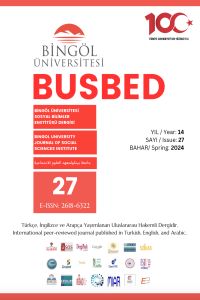Abstract
Halı sanatı milattan önceki yüzyıllara kadar uzanan Geleneksel Türk Sanatlarından birisidir. Halı dokumacılığının ne zaman başladığı kesin olarak bilinmemektedir. Pazırık halısı, günümüze kadar ulaşmış en eski düğümlü dokuma örneğidir. Muhteşem motif ve renkleriyle dikkat çeken bu halı dışında yine Türkiye’nin birçok bölgesinde ulaşılan örnekler halı sanatının ne kadar köklü bir geçmişe dayandığını göstermektedir. Kars ve çevresinde de yıllar boyu halı, kilim gibi çeşitli kirkitli dokumalar yapılmıştır. Fakat bugün yöreye has özellikleriyle dikkat çeken bu halılar evlerde yok denecek kadar az sayıdadır. Birbirinden değerli halıları ancak müzelerde görmek mümkündür. Kültürel mirası korumak, unutulmaya yüz tutan sanat eserlerini hatırlatmak, gelecek kuşaklara aktarmak amacıyla kurulan müzeler, ülkemizde çok sayıda değerli eseri barındırmaktadır. Kars Müzesi de bu eserlerin sergilendiği müzeler arasındadır.
Bu araştırma Sanatta Yeterlik tez çalışması için Kars Müzesi’nden alınan izin ile bizzat yapılmıştır. Müzenin etnagrafik eserler bölümünde birbirinden değerli el dokuması halılar arasından rastgele seçilen ve tez kapsamına dahil edilmeyen 8 adet halı araştırma konusunu oluşturmaktadır. Müze yetkilileri tarafından oluşturulan envanter bilgilerine ek olarak 8 adet halının motif, desen, renk, teknik ve kompozisyon özellikleri ayrıntılı olarak açıklanmıştır. Bu araştırma, kültürel mirasımız olan el dokuma halıların önemini belirlemek ve bu değerli mirası koruma bilincini artırmak açısından önem taşımaktadır.
References
- Anonim (1991). Halılar – El Dokuması – Halı Sırtı Üzerindeki İlmek Uçlarının Etkin Hav Boyunun Tayini. TSE Yayını No: 2893. Ankara.
- Deniz, B. (2010). Azerbaycan ve Anadolu-Türk Halılarının Benzer Özellikleri. Güzel Sanatlar Enstitüsü Dergisi, 18, 17-61.
- Erbek, M. (2002). Çatalhöyük’ten Günümüze Anadolu Motifleri. T.C. Kültür Bakanlığı.
- Görgünay-Kırzıoğlu, N. (1999). Cumhuriyetimizin 75. Yılında Kars. Kars Valiliği.
- Hamidova, Ü. (2020). Kars ve Azerbaycan’ın Gence-Kazah Grubu İçinde Yer Alan Karapapak Halıları. Arış Dergisi, (16) , 90-111.
- URL 1: Kars Arkeoloji ve Etnografya Müzesi (ktb.gov.tr).
- Stone, P. F. (1997). The Orıental Rug Lexicon. Hong Kong: Thames and Hudson.
Abstract
Carpet art is one of the Traditional Turkish Arts dating back to centuries before Christ. It is not known exactly when carpet weaving began. Pazyryk carpet is the oldest example of knotted weaving that has survived to the present day. Apart from this carpet, which attracts attention with its magnificent motifs and colors, examples found in many regions of Turkey show how deep-rooted the art of carpets is. Various kirkit weavings such as carpets and rugs have been made in Kars and its surroundings for years. However, today these carpets, which attract attention with their unique features, are almost absent in homes. It is possible to see valuable carpets only in museums. Museums, which were established to protect cultural heritage, to remind us of works of art that are about to be forgotten, and to pass them on to future generations, contain many valuable works in our country. Kars Museum is among the museums where these works are exhibited.
This research was conducted personally with the permission received from the Kars Museum for the thesis study of Proficiency in Art. The subject of the research is 8 carpets, randomly selected from among the valuable hand-woven carpets in the ethnographic works section of the museum and not included in the scope of the thesis. In addition to the inventory information created by the museum officials, the motifs, patterns, colors, technical and composition features of the 8 carpets are explained in detail. This research is important in determining the importance of hand-woven carpets, which are our cultural heritage, and increasing awareness of protecting this valuable heritage.
References
- Anonim (1991). Halılar – El Dokuması – Halı Sırtı Üzerindeki İlmek Uçlarının Etkin Hav Boyunun Tayini. TSE Yayını No: 2893. Ankara.
- Deniz, B. (2010). Azerbaycan ve Anadolu-Türk Halılarının Benzer Özellikleri. Güzel Sanatlar Enstitüsü Dergisi, 18, 17-61.
- Erbek, M. (2002). Çatalhöyük’ten Günümüze Anadolu Motifleri. T.C. Kültür Bakanlığı.
- Görgünay-Kırzıoğlu, N. (1999). Cumhuriyetimizin 75. Yılında Kars. Kars Valiliği.
- Hamidova, Ü. (2020). Kars ve Azerbaycan’ın Gence-Kazah Grubu İçinde Yer Alan Karapapak Halıları. Arış Dergisi, (16) , 90-111.
- URL 1: Kars Arkeoloji ve Etnografya Müzesi (ktb.gov.tr).
- Stone, P. F. (1997). The Orıental Rug Lexicon. Hong Kong: Thames and Hudson.
Details
| Primary Language | Turkish |
|---|---|
| Subjects | Carpet, Rug and Textiles |
| Journal Section | Articles |
| Authors | |
| Early Pub Date | April 29, 2024 |
| Publication Date | April 30, 2024 |
| Submission Date | March 3, 2024 |
| Acceptance Date | April 27, 2024 |
| Published in Issue | Year 2024Issue: 27 |



